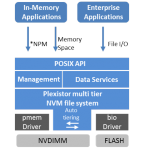I’m really excited about the prospects of memory-addressable flash. Moving flash closer to the CPU and addressing it as memory rather than block storage brings tremendous performance benefits, and is a once-in-a-generation radical change to system architecture. But questions remain as to how it can be integrated with today’s applications. Now Plexistor is here with a promising solution: Their “Software-Defined Memory” concept is a generic filesystem for storage, from NVDIMM to NVMe to SSD.
ioMemory
Thinking About Storage In a New Way, From Cloud to Flash, with Dropbox and Fusion-io
I’ve been a storage revolutionary for quite a while, looking for new ways of data storage rather than technologies that perpetuate the same old approaches. That’s why I’m excited about the implications of two very different API access methods announced by Dropbox at DBX and by Fusion-io today at OSCON.
Can Fusion-io Survive Commoditization?
No small storage company has had more press coverage and “buzz” than “ioMemory” maker, Fusion-io. I have long marveled at the company’s ability to attract attention, but this has rub some analysts wrong. How, they argue, as component vendors enter their space, can a premium company with proprietary products compete over the long term?
Fusion-io Hits the Mass Market with the Affordable ioFX Card
The ioFX was the highlight of NAB Show 2012 to me. Bringing massive performance to the masses, the ioFX continues Fusion-io’s tactic of shaking up the industry. And since it uses the same ioMemory architecture and drivers as the flagship ioDrive line, I expect Fusion-io will have difficulty keeping up with demand.



